

Our closest ape-like ancestor went back to the trees - life - 11 April 2013. Our closest non-human ancestor lived in South Africa.
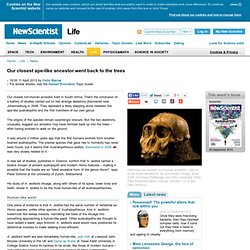
That's the conclusion of a battery of studies carried out on two strange skeletons discovered near Johannesburg in 2008. They represent a likely stepping stone between the ape-like australopiths and the first members of our own genus. The origins of the species remain surprisingly obscure. But the two skeletons, unusually, suggest our ancestor may have climbed back up into the trees – after having evolved to walk on the ground. It was around 2 million years ago that the first humans evolved from smaller-brained australopiths. . , was very closely related to it. A new set of studies, published in Science, confirm that A. sediba carried a bizarre mosaic of ancient australopith and modern Homo features – making it possible that the fossils are an "ideal ancestral form of the genus Homo", says Peter Schmid at the University of Zurich, Switzerland. Stone tools helped shape human hands - life - 11 April 2013.
AROUND 1.7 million years ago, our ancestors' tools went from basic rocks banged together to chipped hand axes. The strength and dexterity needed to make and use the latter quickly shaped our hands into what they are today – judging by a fossil that belongs to the oldest known anatomically modern hand. The 1.7-million-year-old Acheulean hand axes were some of the first stone tools. Over the next million years, these chunky teardrop-shaped rocks became widely used before being replaced by finer, more precise flint tips.
But how our ancestors' hands evolved into a shape that could make such tools is a bit of a mystery. Before the hand axes appeared, our ancestors had primitive wrists: good for hanging from branches, but too weak to grasp and handle small objects with much force. In 2010, a team led by Fredrick Kyalo Manthi of the National Museums of Kenya discovered an intriguing bone in the north of the country. Introduction: Human Evolution. Interactive Movie - Becoming human: A timeline of human evolution. Human Evolution. Cookies on the New Scientist website close Our website uses cookies, which are small text files that are widely used in order to make websites work more effectively.

To continue using our website and consent to the use of cookies, click away from this box or click 'Close' Find out about our cookies and how to change them Log in Your login is case sensitive I have forgotten my password close My New Scientist Look for Science Jobs. Evolutionary theory can make street life better - life - 29 August 2011. Read full article Continue reading page |1|2 Can we use evolutionary biology to improve people's lives?
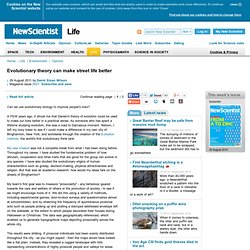
A FEW years ago, it struck me that Darwin's theory of evolution could be used to make our lives better in a practical sense. As someone who has spent a lifetime studying evolution, this was a road to Damascus moment. Reborn, I left my ivory tower to see if I could make a difference in my own city of Binghamton, New York, and worldwide through the creation of the Evolution Institute, the world's first evolutionary think tank. My new mission was not a complete break from what I had been doing before. Human Evolution. Microraptor's glossy black feather coat reconstructed - life - 08 March 2012. Interactive Movie - Becoming human: A timeline of human evolution. Chinese human fossils unlike any known species - life - 14 March 2012. And so it begins.
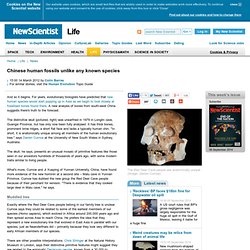
For years, evolutionary biologists have predicted that new human species would start popping up in Asia as we begin to look closely at fossilised bones found there. A new analysis of bones from south-west China suggests there's truth to the forecast. The distinctive skull (pictured, right) was unearthed in 1979 in Longlin cave, Guangxi Province, but has only now been fully analysed. It has thick bones, prominent brow ridges, a short flat face and lacks a typically human chin.
"In short, it is anatomically unique among all members of the human evolutionary tree," says Darren Curnoe at the University of New South Wales in Sydney, Australia. The skull, he says, presents an unusual mosaic of primitive features like those seen in our ancestors hundreds of thousands of years ago, with some modern traits similar to living people. Muddled tree Exactly where the Red Deer Cave people belong in our family tree is unclear.
There are other possible interpretations. Promoted Stories. Gorilla DNA unlocks secrets of our species - life - 07 March 2012. THANKS to Kamilah the gorilla, the last of the great apes has had its genome fully sequenced.
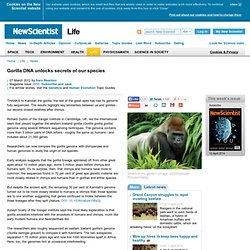
The results highlight key similarities between us and gorillas - our second closest relatives after chimps. Richard Durbin of the Sanger Institute in Cambridge, UK, led the international team that pieced together the western lowland gorilla (Gorilla gorilla gorilla) genome using several different sequencing techniques. The genome contains more than 3 billion pairs of DNA letters - roughly the same as humans - and includes about 21,000 genes. Researchers can now compare the gorilla genome with chimpanzee and human genomes to study the origin of our species. Early analysis suggests that the gorilla lineage splintered off from other great apes about 10 million years ago, some 3 million years before chimps and humans split. The researchers also roughly sequenced an eastern lowland gorilla's genome (Gorilla beringei graueri) to compare it with Kamilah's.
That seems to be quite common, says Scally. Deep sea fishing for tuna began 42,000 years ago - life - 24 November 2011. Tuna has been on the menu for a lot longer than we thought.
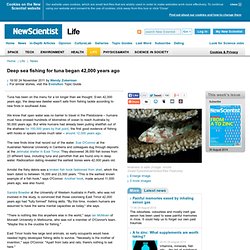
Even 42,000 years ago, the deep-sea dweller wasn't safe from fishing tackle according to new finds in southeast Asia. We know that open water was no barrier to travel in the Pleistocene – humans must have crossed hundreds of kilometres of ocean to reach Australia by 50,000 years ago. But while humans had already been pulling shellfish out of the shallows for 100,000 years by that point, the first good evidence of fishing with hooks or spears comes much later – around 12,000 years ago. The new finds blow that record out of the water. Sue O'Connor at the Australian National University in Canberra and colleagues dug through deposits at the Jerimalai shelter in East Timor. Amidst the fishy debris was a broken fish hook fashioned from shell, which the team dated to between 16,000 and 23,000 years. East Timor hosts few large land animals, so early occupants would have needed highly developed fishing skills to survive. Promoted Stories. Sharp Stone Age spearheads were cooked then flaked.
If you want to make really sharp stone spearheads, do like Stone Age cave dwellers did and cook them first.
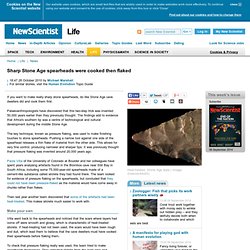
Palaeoanthropologists have discovered that this two-step trick was invented 50,000 years earlier than they previously thought. The findings add to evidence that Africa's southern tip was a centre of technological and cultural development during the middle Stone Age. The key technique, known as pressure flaking, was used to make finishing touches to stone spearheads.